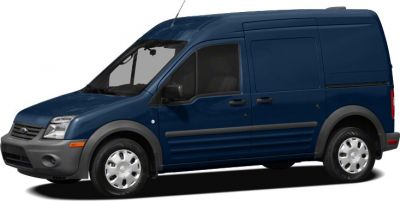 2010 Ford Transit Connect I (facelift 2009) Panel Van L1H1 Dimensions, Size & Specs
2010 Ford Transit Connect I (facelift 2009) Panel Van L1H1 Dimensions, Size & SpecsMeasurements of the 2010 Ford Transit Connect I Panel Van L1H1, engineered for optimal performance and comfort
| Dimensions | |
|---|---|
| Length: | 4275 mm168.3 in14.0 ft |
| Width: | 1795 mm70.7 in5.9 ft |
| Width (Opened Mirrors): | 2044 mm80.5 in6.7 ft |
| Height: | 1815 mm71.5 in6.0 ft |
| Ground Clearance: | 166 mm6.5 in0.5 ft |
| Trunk Capacity: | 2800 liter98.9 cu ft |
| Trunk Capacity (Max): | 3400 liter120.1 cu ft |
| Weight Specifications | |
| Curb Weight: | 1388-1402 kg3060-3091 lbs |
| Maximal permitted Weight: | 2040 kg4497 lbs |
| Tire Specifications | |
| Rims Size: | 15-inch rims:
|
| Tire Size: |
|
The 2010 Ford Transit Connect I (facelift 2009) Panel Van L1H1 is a versatile minivan designed to offer ample cargo space while maintaining compact dimensions suitable for urban and commercial use. Produced between 2009 and 2013, this generation facelift brought refined styling and practical enhancements to the Transit Connect lineup. The van measures 4275 mm (168.3 inches) in length and 1795 mm (70.7 inches) in width, expanding to 2044 mm (80.5 inches) when the mirrors are opened. With a height of 1815 mm (71.5 inches), the Transit Connect provides a balanced profile for maneuverability and interior volume. Its curb weight ranges from 1388 to 1402 kg (3060 to 3090 lbs), making it relatively lightweight, which contributes to efficient handling and fuel economy. It supports a maximum weight of 2040 kg (4497 lbs), allowing it to carry substantial payloads for a vehicle in its class. Cargo capacity is a key strength of this model, offering 2800 liters (98.9 cubic feet) of luggage space, which increases to an expansive 3400 liters (120.0 cubic feet) with the rear seats folded. This makes it ideal for businesses requiring flexible load configurations. The vehicle’s ground clearance stands at 166 mm (6.5 inches), suitable for urban driving and light off-road conditions. It rides on 15-inch rims (6J x 15) fitted with tires sized 195/65 R15, balancing comfort and practicality. Overall, the 2010 Ford Transit Connect I facelift L1H1 Panel Van blends size efficiency with cargo versatility, making it a practical choice for small business owners and delivery services that need a compact yet capacious minivan.
Discover the standout features that make the 2010 Ford Transit Connect I Panel Van L1H1 a leader in its class
Have a question? Please check our knowledgebase first.
The 2010 Ford Transit Connect I (facelift 2009) Panel Van L1H1 has a length of 4275 mm (168.3 inches), a width of 1795 mm (70.7 inches) excluding mirrors, and a width of 2044 mm (80.5 inches) with mirrors opened. Its height measures 1815 mm (71.5 inches). These dimensions make it a compact yet spacious minivan ideal for commercial and personal use.
The curb weight of the 2010 Ford Transit Connect I Panel Van ranges from 1388 kg to 1402 kg (approximately 3060 to 3092 pounds). Its maximum allowable weight is 2040 kg (about 4497 pounds). This weight range balances cargo load capacity with fuel efficiency, making it suitable for both city and highway driving with substantial payload capabilities.
The interior luggage capacity of the 2010 Ford Transit Connect I Panel Van L1H1 stands at 2800 liters (98.85 cubic feet) with the rear seats in place. When the rear seats are folded, the capacity expands to 3400 liters (120.07 cubic feet). This significant increase highlights its versatility, accommodating a wide range of cargo sizes, making it flexible for both daily tasks and larger transportation needs.
The ride height or ground clearance of the 2010 Ford Transit Connect I Panel Van is 166 mm (6.54 inches). This moderate ground clearance provides a good balance between urban usability and light off-road capability, allowing the vehicle to handle speed bumps and uneven surfaces comfortably without compromising stability.
The 2010 Ford Transit Connect I Panel Van is equipped with 6J x 15 rims, paired with tires sized at 195/65 R15. This combination ensures a smooth ride quality and adequate grip while maintaining fuel efficiency and handling characteristics suitable for a minivan designed for urban and suburban use.
With a length of 4275 mm (168.3 inches), a width of 1795 mm (70.7 inches) excluding mirrors, and a height of 1815 mm (71.5 inches), the 2010 Ford Transit Connect I Panel Van typically fits into a standard garage. However, the width with mirrors opened is 2044 mm (80.5 inches), so care must be taken when maneuvering in tighter spaces. Generally, it should fit comfortably in most residential garages built for SUVs and vans.
The 2010 facelifted Transit Connect I maintains similar overall dimensions to the original first generation but features subtle refinements. While the length remains around 4275 mm, the facelift brought design tweaks for slightly enhanced interior space utilization and improved aerodynamics. Width and height measurements stayed consistent, preserving the practical cargo volume and maneuverability that defined the earlier model.
The 2010 Ford Transit Connect I (L1H1) offers competitive dimensions within the compact panel van segment. Its length of 4275 mm (168.3 inches) places it between smaller city vans and larger commercial vehicles, while the cargo capacity of up to 3400 liters (120.07 cubic feet) with folded seats is notably generous. Compared to rivals like the Citroën Berlingo or Volkswagen Caddy, the Transit Connect balances cargo space and maneuverability effectively, making it a strong contender for urban deliveries and light commercial use.
The 2010 Ford Transit Connect I Panel Van L1H1 is primarily designed as a compact commercial vehicle with versatile cargo space. While seating capacity varies depending on configuration, it usually accommodates two or three passengers in the front cabin. The emphasis is on maximizing cargo volume and payload rather than passenger comfort, making it ideal for businesses requiring efficient transport of goods in urban environments.
The 2009 facelift of the Ford Transit Connect I introduced several enhancements carried into the 2010 model year. These included updated front and rear styling for a more modern appearance, improved interior materials and ergonomics for driver comfort, and minor suspension tweaks to enhance ride quality. Additionally, this facelift helped improve fuel efficiency and emissions, aligning the vehicle with contemporary standards without altering its fundamental practical dimensions.
Discover similar sized cars.

| Production: | 2009-2013 |
|---|---|
| Model Year: | 2010 |
| Length: | 4275 mm168.3 in |
| Width: | 2044 mm80.5 in |
| Height: | 1815 mm71.5 in |

| Production: | 2006-2009 |
|---|---|
| Model Year: | 2007 |
| Length: | 4308 mm169.6 in |
| Width: | 2044 mm80.5 in |
| Height: | 1814 mm71.4 in |
